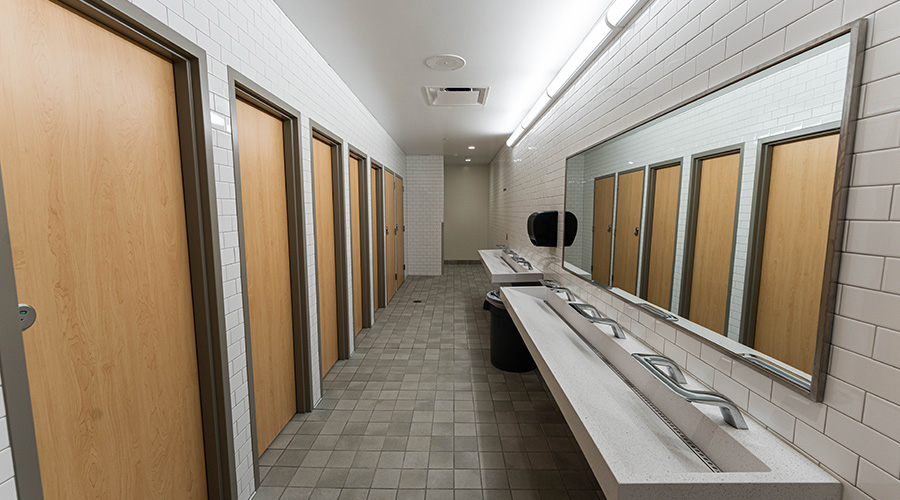 The germicidal 405 nm luminaires provide bright illumination and their sealed enclosure housing prevents harboring of bacteria inside the luminaires.Kenall Lighting/Skyline High School
The germicidal 405 nm luminaires provide bright illumination and their sealed enclosure housing prevents harboring of bacteria inside the luminaires.Kenall Lighting/Skyline High SchoolUtah High Schools Upgrades Lighting, Prevents Spread of Illness
Granite School District has upgraded its lighting choices for new buildings to kill harmful viruses and bacteria.
By Amy Wunderlin, Contributing Writer
OTHER PARTS OF THIS ARTICLEPt. 1: This Page
School buildings have come a long way from the 80s. While once built with simple designs and one goal in mind—to provide a place for children to learn—schools now act as community centers, with shared spaces and extended hours of use. The way kids learn has also changed significantly, requiring more technology and more flexible and adaptable learning areas.
On top of all these changes, schools are constantly facing new threats, and keeping students safe from violence and illness is a top consideration when districts plan new facilities.
For Granite School District in Salt Lake City, Utah, the latter was especially important as plans for two new high schools began in the middle of the Covid-19 pandemic. The district chose to install disinfecting lighting in each athletic building to help kill harmful viruses and bacteria automatically and continuously in the air and on surfaces.
“We looked at doing it for the whole school, not just the athletics areas, and it just ended up way too expensive, so we focused on the areas that might be a little sweatier,” says Philip Borup, electrical engineer and project manager, Envision Engineering. “The idea was…if we could disinfect those areas with the lighting, then that should cut down on the on those viruses and germs.”
The construction of Skyline High School and its twin school Cypress High School was the first time Envision Engineering had installed this type of lighting system in a school building, making it among the most unique features of the facilities.
Construction of the two schools is scheduled to be completed in December 2026 and was done in phases so students were not displaced during the process. The $168 million Cyprus campus and $174 million Skyline project, which are nearly identical buildings, are bringing the greater Salt Lake City area into the future as they embrace modern amenities across facilities.
“They didn't want just a 1980s building,” says Michael Hall, senior project executive and education planner, Fanning Howey. “The district took a pretty strong lead in moving the whole design process into a 21st century facility.”
Germicidal lighting reduces illness and lowers costs
Lighting was a big part of that 21st century facility. The project managers worked with Quantum Lighting Group of Salt Lake City who chose Indigo-Clean luminaires from Kenall Manufacturing to help the district protect students and staff against illness. Their germicidal lighting was installed throughout both high school’s athletic facilities, including all liner surface-mounted fixtures in locker rooms and pendant-mounted fixtures in the weight and wrestling rooms, as well as in recessed fixtures in the cardio room. Downlights were installed in the toilet stalls, dressing rooms and shower stalls.
The athletic facility was a natural fit for this type of lighting because it is an area more susceptible to germs and bacteria, with studies documenting the presence of excessive bacterial burden in both high school and collegiate training room facilities.
“Athletic training rooms have a high prevalence of bacteria, including multidrug-resistant organisms, increasing the risk for both local and systematic infections in athletes,” says Garrett Ledger, director of Specification Sales, Quantum Lighting Group.
He adds that these studies have also found that adaptation of an automatic-hygiene protocol can lead to a reduction in bacterial and viral pathogen counts in these spaces, where close contact among athletes and the presence of poor hygiene and contamination can predispose athletes to infection.
A big benefit to Indigo-Clean’s lighting is that it works 24/7 to automatically kill organisms such bacteria, viruses, molds, yeast, and fungi in the air and on surfaces without the need for specially trained staff. The technology uses visible light known as 405 nanometer (nm) to disinfect. Unlike UV lighting, which can be harmful to people, 405 nm is safe for humans, low maintenance, cost-effective, and requires no special staff or training to operate.
“405 nm visible light is both direct and indirect, reflecting off walls and other surfaces where it kills pathogens in shadowed areas UV lighting simply can't reach,” says Ledger. “Research has shown that 405 nm visible light can kill enveloped viruses such as SARS-CoV-2 and Influenza-A H1N1 without the use of photosensitizers, meaning it provides continuous environmental disinfection against these pathogens.”
Ledger worked with the manufacturer and engineers to calculate the appropriate lighting level for each room, using common illuminance levels for general lighting applications, the fixture designs, and previous clinical studies.
“We do lighting calculations in almost every room just to see how much light we're getting and designed to the right levels,” explains Borup. “With this lighting, basically the brighter it is, the more effective it is…so we had to do some extra lighting calculations to make sure that was all fine-tuned and we're getting the right amount of light to actually be effective.”
While the initial goal of installing the lighting was to reduce amount of illness in the schools, the district also hopes to lower maintenance costs due to the energy efficiency of LED technology. LED fixtures have a longer lifetime then legacy lighting technologies, which may help to reduce maintenance costs for the school district throughout the life of the installation.
“While not commonly used in educational settings, disinfecting lighting like Indigo-Clean is gaining attention because of the myriad benefits and costs savings,” says Ledger.
Ledger notes that germicidal lighting is designed to address entire facilities, from healthcare areas where the risk of infection is highest, to classrooms, conference rooms, waiting rooms, and other high-traffic spaces.
Modern solutions take district into the future
Skyline High School was designed to be adaptable for flexible learning as curriculums change over its life expectancy of 50 to 60 years.
“Learning is changing, and technological access is changing,” says Hall, noting that this has changed the picture of what a high school should look like.
Skyline and Cypress High Schools were set up to best reflect these changes with collaborative classrooms areas wrapped in glass. Natural light and flexibility were pillars of the design process, so that rooms could be used across subject matters and outside of typical school hours. The buildings are set up so they can be operational from sunup to sundown every day, becoming Hall says is an 18 hour a day learning center.
“Those buildings are technologically rich,” says Hall. “One, because we can do it, but again, because we have to do it for safety and for security. It’s a different ball game than it used to be, and it's driven by society…it makes the timing of education longer during the day, more flexible.”
Hall adds that the design of these high schools is intended to prepare students for the future. Whether that means college or entering the workforce, kids must be technologically proficient, and for students in Salt Lake City, that can now start in the halls of their high school.
Amy Wunderlin is a freelance writer based in Fort Atkinson, Wi.
Related Topics:












